
The
Resurrection of Jesus
A harmony of the
resurrection accounts
Based upon the
outline given in Reason & Faith,
R Forster & P Marston, Monarch Publications, 1989, p 79 - 108
Contents
Characters in the story, locations featured, and writers of the records
If what is recorded in the New Testament is true, the resurrection of Jesus is the most incredible and most significant event in the whole of human history. There are five passages in the New Testament that claim to be historical accounts of what happened to Jesus, and these are:
Since Christianity stands or falls on whether the resurrection of Jesus was an actual, real, historical event (1 Corinthians 15:12-19), we need to ask the question, what marks the five accounts above out as genuine, independent (or semi-independent) accounts of actual historical events? In short, how can we trust them? I will begin by making some general observations concerning eye-witness accounts and historical writing in general.
(For further reading on the subject of historical credibility, E H Carr’s What is History? (1987) contains much of value, as does G R Elton’s The Practice of History (1969) and the summary contained in Colin Brown’s History and Faith (1987)).
The rest of this paper sets out to answer the question, do the New Testament accounts of the crucifixion and resurrection of Jesus hold up to points 1 - 4 above. Simply put, are they true? In particular, we will compare the eye-witness accounts given in the five sources listed above and see whether, taken together, they can be used to form a reconstruction of the events, or whether they are full instead of hopelessly irreconcilable contradictions. The harmony of the five accounts put forward is here is also accompanied with numerous diagrams to help the reader follow the reconstruction.
The people who feature in the accounts of the resurrection of Jesus are as follows:
The diagram below shows Jesus’ immediate family relationships:

Locations featured in this reconstruction

The following is evident from the way that the four gospel writers have treated their material, and it is important to keep these two points in mind as we proceed:
The scene is set : Jesus’ arrest and crucifixion
Jesus was arrested late at night in the Garden of Gethsemane, betrayed into the hands of his enemies by Judas Iscariot, who had been one of the twelve disciples. After Jesus’ arrest, his disciples scattered, in fear for their lives. Peter and John followed him to Jerusalem, the others ran off. The most logical place to run to would have been Bethany; it was in the opposite direction to the city, only a mile away, and more importantly, they had good friends there in the shape of Mary Magdalene, Martha, and Lazarus. These disciples are mentioned no more until the evening of the resurrection. The one exception to all this is Thomas, who may have gone further afield.
Many were watching Jesus’ death on the cross that day, and among them were Mary Magdalene, and Jesus’ aunts Salome and Mary (wife of Cleopas), his mother, and his beloved cousin, John (Matthew 27:56; John 19:25-26). Jesus committed his mother into the care of John (who was her nephew), and it is recorded that "from that hour" John took her into his home, which was in south Jerusalem. Her sister Salome probably also went to John's home, to comfort Mary in her grief. John had already taken Peter there, a broken and desolate man after he had denied Jesus three times during their visit to the house of Caiaphas the night before.
The body of Jesus was taken down from the cross by Nicodemus and Joseph of Arimathea, who had sought permission from Pilate to do so. They took the body to the nearby tomb owned by Joseph, where the Jewish burial custom of wrapping the corpse with spices and linen was begun. However, because of the impending high Sabbath, this task was not finished. Several women, including both Mary’s, watched this, and as the Sabbath drew on they retired back to the house of John, where, as recorded by Luke (23:26), they "rested on the Sabbath".
However, for obvious reasons, there was much anxiety on the part of the authorities this Sabbath. Whilst they had finally rid themselves of that irksome troublemaker, Jesus, they were concerned about what his disciples might do. Some recalled how Jesus had taught that he would rise from the dead after three days, and they began to worry that his disciples might somehow try to steal his body from the grave to make it seem that this had indeed happened. A martyred troublemaker was one problem, but rumours of a risen and resurrected one would be worse! Thus the Jewish authorities obtained permission from Pilate to place a Roman guard on the tomb (Matthew 28:11-15). Jesus’ friends, passing the Sabbath in the homes of John in Jerusalem and Mary, Martha, and Lazarus in Bethany knew nothing of these machinations at this time.
| The diagram below shows the locations of people on that Sabbath day | |
 |
Joanna is with her husband in the old Hasmonaean Palace, residence of Herod Antipas. Also staying there is her friend Susanna. Most of the disciples have fled to Bethany. The rest are at John’s house in south Jerusalem, with the possible exception of Thomas, who may have gone further afield. |
| Location of people on the night after the Sabbath (which finished at sunset) | |
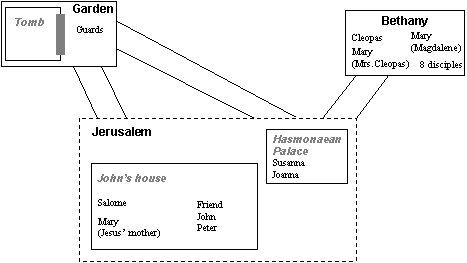 |
Mary Magdalene has returned home to Bethany. With her have gone Cleopas and his wife Mary to see the disciples; among them were their son James the Younger and their nephew, James. |
The gospel writer Matthew, who was at Bethany with seven of the other disciples, reports how Mary Magdalene and Mary the wife of Cleopas set out "at dawn" (Matthew 28:1). Cleopas probably accompanied them. They first visited John’s house, where Cleopas remained and the two Mary’s, joined now by Salome, set off to call for Joanna at the Hasmonaean Palace. Mark, who gives Peter’s version of events, says that the three women set off "very early" and reached the tomb just after sunrise (Mark 16:1-2). Luke, who compiled his account from various sources and eye-witnesses, includes Joanna in his list of women, and gives the time as "very early" (Luke 24:1).
Thus to summarise:
Next, Matthew informs us that after the two Mary’s left Bethany, the four soldiers who made up the Roman guard experienced an earthquake. They briefly glimpsed a vision of a descending angel before, petrified with fear, they passed out. One of the rings of truth in this account is that nobody in any of the accounts claims to have seen the actual moment of resurrection. If the accounts had been fabricated, there would have been a glorious opportunity to really go to town and invent this part of the story.
| Locations of characters early that Sunday morning | |
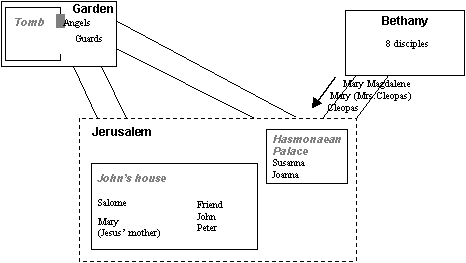 |
Mary Magdalene, Cleopas, and his wife have set out to John’s house in Jerusalem. Meanwhile, at the tomb, the guards have been stunned by the appearance of the angels, who roll back the stone sealing the entrance to the tomb. The guards faint in terror. |
When the guards came round, they would have discovered the tomb empty; they were now guilty of a capital offence under Roman law, and so they fled in terror. Their only hope were the Jewish authorities who agreed to use their influence if the soldiers spread the story that the disciples had come in the night and stolen the body of Jesus. No bribe could have kept the soldiers totally quiet, and thus Matthew (perhaps through his old friends from his days as a collaborator) heard the story and was able to record it. It may also be true that as the most Hebrew orientated of the gospel writers, he especially wanted to counter the "stolen body" myth, given that the Jews were still using it years later. So to return to the reconstruction, as the women were on their way to the tomb, the soldiers were running away!
| Movements early that Sunday morning | |
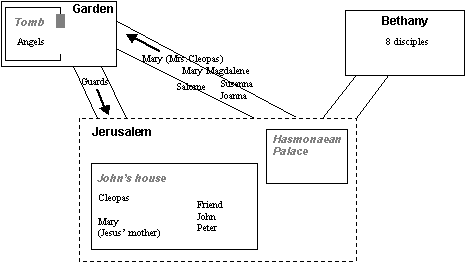 |
Cleopas remains at John’s house, whilst the two Marys, along with Salome, have called for Joanna and Susanna. The five women now head for the tomb to do the women’s work of anointing the body. Meanwhile, the guards have recovered and are running back to tell the authorities of their experience. The angels are waiting inside the tomb. |
Unaware of events at the tomb, the five women arrive, as they approach discussing the impending problem of how they would get the stone rolled away from the entrance to the tomb (Mark 16:3). Still some way off the tomb, they see in the distance that the stone has already been moved. Quickly jumping to the conclusion that the authorities must have opened the tomb and moved the body, Mary Magdalene turns on her heel, running back to in panic and grief to cry those now famous words to John: "They have taken the Lord out of the tomb, and we don’t know where they have laid him!" (John 20:2). Note the two very important points of cross corroboration here:
This also explains why Mary did not mention the angels when she spoke to John. Again, we need to look at the details that the other gospel writers provide; Matthew reports the initial descent of the angel, only seen by the Roman guards. Mark and Luke report that when the women arrived, the angels were inside the tomb. So when did Mary turn back? According to John, when she saw that the stone had been removed from the entrance. And when was that? Mark provides the answer: ‘When they looked up, they saw that the stone had been removed from the entrance’ (Mark 16:4). By reading all the gospel accounts, we have the complete picture:
Not only do these accounts fit together perfectly, but we can see why, for John, it is important that Mary Magdalene did turn back and race back to Jerusalem. It was her report that led to him personally visiting the tomb and experiencing the renewal of his faith. To the other three gospel writers, it was a minor detail, since Mary, like the other four women, could later report seeing both the angels and the risen Lord Jesus.
| The women arrive at the garden and the tomb | |
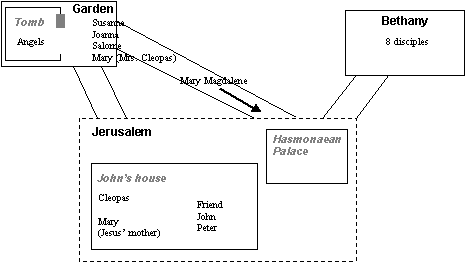 |
The women have reached the edge of the garden, and have seen in the distance that the stone sealing the tomb has been rolled away. Mary Magdalene jumps to the conclusion that the authorities have taken the body, and races back to Jerusalem to tell Peter and John. |
At a casual glance, it seems that there might be a contradiction in the accounts over the angels. After all:
Firstly, it is important to note that the Bible nowhere portrays angels as winged figures carrying harps! Rather, they are always portrayed simply as men (e.g. Joshua 5:13-15). Thus, for example, there is no contradiction when Luke speaks of "men" (24:4) yet later records Cleopas speaking of a "vision of angels" (24:23). And there is no contradiction between the gospel accounts which speak of "men in white" and those that speak of "angels".
Neither is the number of angels a problem, despite the attempts by some sceptics to highlight this as an apparent contradiction. The question has simply arisen because Matthew and Mark mention one angel, whereas Luke and John both refer to two. However, unless the angels spoke in simultaneously, then it seems obvious that one was the spokesperson of the pair. Matthew and Mark may very well have been aware that angel who spoke had a companion. But all historians, whether sacred or secular, decide which details to record, and what secular historian would be pronounced unreliable for failing to mention that an important speaker had a companion with him or her? It is not vital to the account, and whether or not to mention it is simply a matter of personal choice.
Again, whilst the gospel writers record different parts of the angel’s speech, those parts fit together remarkably well. Even more surprising is that Luke and Mark seem fairly parallel on the parts up to the angel’s speech which Matthew omits, but on the speech itself it is Luke who differs and Matthew and Mark who are parallel. This is exactly what one might expect of three accounts which were independently compiled, yet drew on some of the same eye-witness reports.
| The four women encounter the angels at the tomb | |
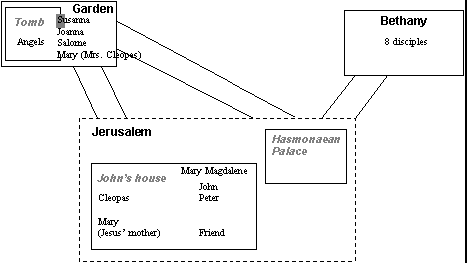 |
The four women enter the tomb, where they encounter the two angels, one of whom gives them a message for the disciples. Meanwhile, Mary Magdalene has reached Peter and John and cried: "They have taken the Lord out of the tomb, and we don’t know where they have laid him!" |
| Mary Magdalene has reached Peter and
John, and tearfully blurted out her worst fears; that the
body of Jesus has been taken, presumably by the
authorities. The two men race back to the tomb, with Mary
following. In the maze of the city streets, they miss the other four women who are even now returning from the tomb, bearing the message from the angel. |
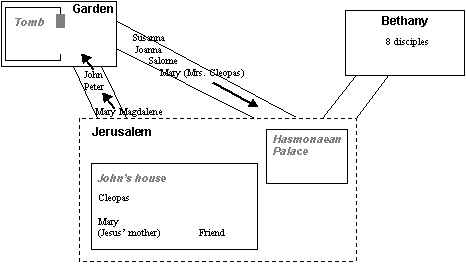 |
| Arriving at the tomb, Peter and John see the empty
tomb, complete with the grave-clothes, but neither the
angels nor the body of Jesus (Luke 24:24; John 20:2-9). Meanwhile, the other four women have arrived back in Jerusalem at the house of John, bearing their news of having seen the angels. One of the angels had given them a message to give to the disciples (Matthew 28:7 and Mark 16:7); a message that specifically included Peter as a recipient. As Peter and John had both run off to the tomb, the women awaited their return. |
 |
| Peter and John now make their way back to the others
in Jerusalem, leaving Mary Magdalene at the tomb, weeping
(John 20:11). Unlike them, when Mary looked into the tomb
she saw the two men in white, although she did not yet
recognise them as angels. Earlier we saw that where she
spoke for all the women, she used the plural we
(John 20:2); now she uses the singular ("I
don’t know where they have put him"). This
is because she no longer knows where the other four women
are, or if they have maybe even located the body (John 20:13). It is then that Mary had her now famous encounter with the risen Jesus (John 20:14-17). John’s account corroborates Mark’s observation that Jesus first appeared to Mary (Mark 16:9). |
 |
Immediately after the return of Peter and John from the tomb, the women hurried off (without waiting for Mary Magdalene) across the Mount of Olives to Bethany, in order to give the amazing news to the other eight disciples there. Among those disciples both Salome and Mary (Mrs. Cleopas) has sons. They were also doing this in order to complete the task that had been given to them by the angels.
As they ran along the road to Bethany, there occurred the meeting with Jesus that is reported by Matthew (28:8-10). Why is Matthew alone in reporting this meeting? For Peter and John in Jerusalem, only Mary Magdalene would have come and spoken of having met Jesus, and thus this is what we find written in John’s gospel and that of Mark (reporting Peter); see John 20:18 and Mark 16:10. Peter, unlike John, did not yet believe (John 20:8) and so Mark’s gospel naturally reflects an unbelief in Mary’s news (Mark 16:10). Matthew, who received the news after waiting in Bethany, naturally telescoped the women’s meetings with the angels and with Jesus - for this would have been how the women reported the events to him, as they excitedly blurted out all that they had seen and heard. The only slight puzzle is Luke, who records neither encounter with Jesus. Two points need making here; firstly, Luke in his chronological account mentions neither the men’s visit to the tomb nor the appearance to Peter himself - yet he clearly refers to both in later reported speech (Luke 24:24,34) so it is obvious that Luke did not intend to imply that his report was complete. Secondly, there is no point in his narrative where he could insert either incident without spoiling the drama of realisation on the Emmaus road and the crescendo of the unmistakable appearance in Luke 24:36. Thus Luke 24:9-12 are a general summary, indicating the main characters and the general atmosphere of unbelief that prevailed. Both Mary Magdalene and the others had seen angels and were generally disbelieved, so what he actually says is true if incomplete.
Two other people had also set out from John’s house in south Jerusalem. Jesus’ uncle Cleopas, having been told of the angels from the group of women (which included his own wife, Mary) set out with a companion to go to Emmaus. Whilst on the road they had the famous encounter that Luke has recorded in Luke 24:13-32. The information given by Cleopas in verses 22-24 exactly match what he would have known in this reconstructed account; he would have known of the women’s encounter with two men in white, and of Peter and John’s experience of discovering the tomb empty. But he and his companion would have set out before Mary Magdalene had returned with the news of having actually seen and spoken to Jesus, and thus neither Cleopas or his friend would have had any idea that Jesus was risen and alive.
| Meetings with Jesus | |
 |
As Mary Magdalene returns from her meeting with the risen Jesus, Cleopas and his friend set out for Emmaus, meeting Jesus on the road. The other four women are heading for Bethany, to tell the disciples (as they were instructed by the angels). As they run along the road, they too meet Jesus. Thus when Matthew is given the news at Bethany, he can be told about both the angels and Jesus at once! |
The
disciples gathered together
When Cleopas and his friend got back to Jerusalem that night, excitedly bearing the news that they had seen Jesus, they found all the disciples gathered. But do Mark 16:13 and Luke 24:34 give conflicting accounts of whether general belief or outright scepticism prevailed? Only a very na´ve reader could see these as being in conflict. Firstly, we may note that Luke, who implies belief, says only a few verses later that they "still did not believe it because of joy" when Jesus himself was standing there! (24:41) One can well imagine Cleopas and his friend bursting into the house to be greeted by a confused babble of comments; "Yes, Peter has also seen him!" "Well, I just don’t believe it!" and so on. The situation simply was not one where a single spokesperson voiced a unanimous opinion. Discussion swayed to and fro, and both Mark and Luke record the various comments that were doubtless made. Then, as the tide may well have been turning towards general scepticism, Jesus himself appeared to them. Even then, some were not convinced, and thought they were seeing a ghost! They wanted more tangible proof, which Jesus offered to them:
"Why are you troubled, and why do doubts arise in your hearts? See my hands and my feet, that it is I myself, for a ghost does not have flesh and bones, as you see that I have." And when he had said this, he showed them his hands and his feet. Luke 24:38-40
| The disciples all meet Jesus | |
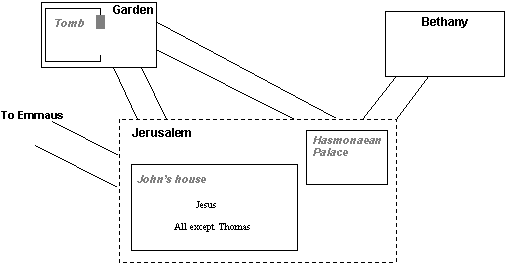 |
All the disciples, with the exception of Thomas, are gathered back in Jerusalem; either in John’s house, or that of John Mark. Jesus appears. Thomas, as yet still a sceptic, will later have his own meeting with Jesus (John 20:24-29); Luke, however, has telescoped the various appearances of Jesus into one. |
We have already noted that Luke telescopes events in his gospel; whilst it may appear at a casual glance that all the events in chapter 24 happened in one day, it is clear from reading Acts (also authored by Luke), that he is totally aware that the events occurred over forty days (Acts 1:3). It was during these forty days that all the other appearances recorded in the gospels occurred; both in Jerusalem and in Galilee. Another interesting corroboration occurs in that it is Matthew (28:7) and Mark (16:7) who record the instruction to the disciples to go to Galilee, whilst it is John who actually reports some of the appearances there (21:1).
Then Jesus told him,
"Because you have seen me, you have believed;
blessed are those who have not seen and yet have
believed."
Jesus did many other miraculous signs in the
presence of his disciples, which are not recorded in this book.
But these are written so that you may believe that
Jesus is the Christ, the Son of God,
and that by believing you may have life in his name."
John 20:29-30
The Resurrection accounts: alternative theories
The five accounts of the resurrections are all from the first-century, written between fifteen and thirty years of the death of Jesus. They fit together in exactly the kind of way we would expect from good historical accounts based on eye-witnesses of the actual events. In fact, the way that they mesh and fit together, containing corroborating cross-details means that they would have been nigh on impossible to fabricate. Time and time again we find that particular details included in the four accounts match the precise position in the events of the main first-hand source of that particular account, be it Matthew, Peter, or John.
The accounts themselves claim to record two historical events: the actual physical disappearance of Jesus’ body from the tomb and the appearances of the risen Jesus to his followers over a period of forty days. As we have already noted above, it is interesting that none of the eye-witnesses claim to have seen the moment of resurrection itself; such an opportunity for exaggeration would not have been missed had the accounts been mere fiction!
So how are these accounts to be explained? Are they telling the truth of a miraculous event, or are there more plausible explanations than the simple one: that they were true? I will end this paper by taking a brief glance over some of the alternative theories that have been forth throughout the years by various sceptics.
The most obvious conclusion, providing one does not come to the Bible with preconceptions (such as the non-existence of miracles, or that Jesus didn’t actually die on the cross), is that the accounts are telling the truth and describe events as the eye-witnesses actually saw them. Jesus Christ rose from the dead, not just in some mystical his ideas and teaching will live on forever sense, but in some sense in which the actual person of Jesus of Nazareth still lives on and interacts with people. It is this that transformed his disciples from a bunch of defeated nobodies into a fearless body of men and women who set out to transform the world, it is this that is the testimony of millions upon millions upon millions of Christians around the world today; Jesus Christ is still transforming lives today, and will continue to do so until he comes back again!
Amen, Come, Lord Jesus.
The grace of the Lord Jesus be with God’s people.
Amen.
Edited for the web by Andy Bannister
Answering Islam Home Page